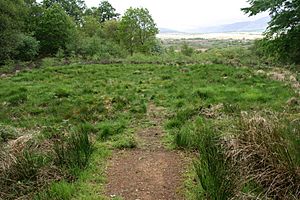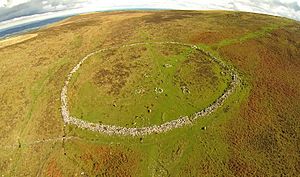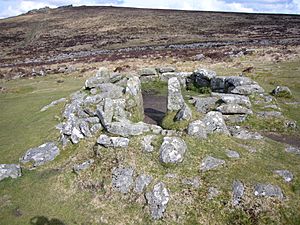Hut circle facts for kids
A hut circle is what archaeologists call the remains of an old house. Imagine a circular or oval shape on the ground, sometimes with a low stone wall around it. This was once the base, or foundation, of a round house. The walls and roof of the house would have been made from wood and thatch, like straw.
These ancient homes are found in many parts of Britain, especially in the uplands. Most of them date back to around 200 BC. Hut circles are usually about 5 to 25 feet (1.5 to 7.6 m) wide inside. The stone foundations themselves are typically 2–3 feet (0.61–0.91 m) wide and about 3 feet (0.91 m) tall. These houses likely had rounded, cone-shaped roofs supported by wooden posts inside and sometimes outside.
Contents
Where Can We Find Hut Circles?
Hut Circles in Wales
Wales has over 100 known hut circles and their surrounding enclosures. You can often find them in areas that have not been ploughed for farming, so the stones remain undisturbed. They are quite common in the northern parts of Wales.
-
Din Lligwy hut circles
-
Hut circle near Aber Falls in Conwy
Hut Circles in England
Many hut circles are found on Dartmoor in England. Experts believe there are about 5,000 of them there! One of the most famous sites is Grimspound. This ancient settlement is very well preserved because its buildings were made from strong stone. The many hut circles at Grimspound are surrounded by a large stone wall. This site dates back to the Late Bronze Age, around 1300 BC.
The 24 hut circles at Grimspound are enclosed by a huge granite wall. This wall might have been as tall as 5 feet 7 inches (1.7 m) in some places. The roundhouses themselves were about 11 feet (3.4 m) wide on average. They were built using two rings of granite slabs with smaller stones packed in between. This building method is still used today for dry-stone walls.
One hut, called Hut 3, even has part of its entrance porch still standing. The two upright stones that formed the doorway are still there, though the stone across the top (called a lintel) has fallen. When archaeologists dug here a long time ago, they found signs that people lived there. They discovered pottery, tools for scraping, and "pot boilers" (stones heated in a fire and dropped into water to cook food). However, not many things made of wood or plants survived because the soil was acidic. Each hut also had a central fireplace where ashes were found.
Another interesting place is Halangy Down in the Isles of Scilly. Here, you can see the remains of an Iron Age village. It's made up of round houses located below the Bant's Carn Bronze Age burial chamber.
Hut Circles in Scotland
Hut circles are also found in Northern Scotland. It's not clear if these are connected to the ones in England. The Scottish hut circles were often found in pairs. They were usually surrounded by groups of ancient burial mounds called tumuli. These hut circles were quite large, about 40 feet (12 m) across, and were typically 20–30 yards (18–27 m) apart.










